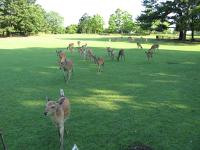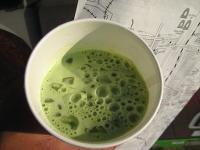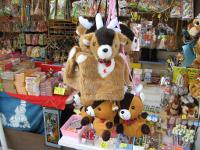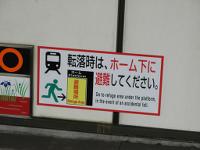***
Japan trip
Day 8 - 13th June - Nara, Kyoto (Part 7)
Essentially all the mobile phones I saw in Japan were clamshell (I saw 2 or 3 slide phones, but it's the same principle). Probably they need the big screen to watch their streaming porn on.

Stream, waterfall

Waterfall
At this point, I decided to spoil the deer's appetite by actively feeding them deer biscuits (oddly, there weren't many deer near Kasuga Taisha).

Deer grazing

Deer attacking me
Attack of the killer deer
Incidentally, I found an answer to one question: how they prevent the deer from goring tourists (and locals, though presumably the locals would have developed avoidance skills). There's a matsuri in October called Shika-no-Tsunokiri (Deer Antler Cutting) where the deer are "wrestled to the ground and their antlers sawn off".
I have also found the probable reason for why the forest was fenced up: an English as a Second Language textbook has an extract about Yuri Maesako, a Nara professor, finding that the deer were debarking the forest, contributing towards deforestation (I can't find anything else in English, though). There's also a 1993 journal article about how fencing off plots allowed tree seedlings to survive and prosper.

Deer trapped in enclosure. I guess it jumped in.

"Don't upset the deer"
Even after enough deer feeding to last me a month, I realised I had a lot of deer biscuits and decided to share the love, and gave them out to random passers-by. One Korean woman declined, and after struggling, came up with the word "afraid". Maybe she'd been mauled by tame deer when she was young, in which case I don't blame her. I saved one deer biscuit for Kofukuji, but when I went there there were no more deer (it was quite quiet and deserted by this time; my grand theory of deer cognition: noise = crowd = people = deer biscuits) so I fed it to birds. After which the deer appeared. Gah.


Five-storied pagoda


"maccha au lait", which I tried.

Vending machines made from recycled tea leaves (?!)

Everyone wearing red votive bibs


Three-storied pagoda
I was considering the pros and cons of having so many deer roam free. Pro: You don't need to cut the grass anymore. Con: There's a smell from the shit (probably it gets really bad only in summer).

Woman walking dog. When the deer came near, she wisely pulled her dog to one side.
The Nara museum was showing treasures from Horyu-ji's Golden Room (since it was being renovated - I guess there are *some* advantages when a place is renovated). The publicity material looked good, but I'd seen a lot of similar stuff (and would see some more), and more importantly I'd already walked extremely far this day (I didn't bother with the buses).

Back of a geisha

Deer hand puppets

Takoyaki shop (as far as I can tell, taco is the only filling you can get here too) and "Japanese Traditional Paper-Face Absorb Paper 'Hiyari'"; I don't know what that is but wouldn't be surprised if it were the ancestor of the blue tracing paper girls use (sidenote: I'm told that it's good because it doesn't smudge your makeup)

"This wretched man ! however much I hear the Dharma, nothing can be done with me."
Nihilistic poem

"Mule Hair & Make
Special Campaign
Color Pass 10,000 yen
Time Service AM9:00~PM3:00
5,000 yen
Stylist Cut: 4,200 yen > 2.800 yen
Top Stylist Cut...
Salon Director Cut...
Art Director Cut"
Stupid advertising pamphlet I got. Another prime example of the Japs' cold blooded murder of the English tongue.
I was hungry, so I decided to once again tuck into a McPork.

Or two. With a tiny Y100 drink again.
However, I went one better this time, and came up with:

Big McPork. Two all-pork patties, special sauce, lettuce, onions on a bun.

Yum

If you thought the Big Mac was substantial, these OMG burgers have 3 patties and an egg, and 4 patties respectively.
For food prepared on the spot (i.e. not onigiri or the like) fast food was definitely the cheapest option in Japan (while McDonalds had their Y100 menu, Wendy's had a Y99 menu - though I didn't try it as it didn't sound appetising). Vegetarian onigiri might cost Y100 if you found the right place, but then it would be cold and vegetarian.
I then returned to Nara. Returning to the hostel I found I still had a lot of time, and since my feet were dying, I decided to visit an Onsen; the Funaoka Onsen was recommended by Lonely Planet so I sought it out. There were better ones, but they were further out - this was in the city itself.

"If you find yourself on the tracks and it's not your intention to kill yourself, here's what you should do"

"44-44" license plate. I'm assuming the car owner wasn't Cantonese. Though apparently it's not a good number for Japs either.

Onsen sign
I found out that nothing was included: not water, the hairdryer (coin-operated), soap or a towel. Naturally I hadn't brought anything (I didn't want to lug stuff around, and it probably was against Jap etiquette to wash with Body Shop shower gel) so I forked out Y390 (I scribbled this number, but it might not have included the extras). The vending machines too were more expensive. This is how they make money.
Although the place was called "Onsen", the water neither smelled nor tasted (shh, I was just making sure) like anything other than ordinary water. So I've no idea why it was called an Onsen, since it's a Sento (public bathhouse).
Unfortunately, I hadn't hydrated myself before entering the water, not least since there wasn't free water, so when I entered one of the 2 hottest pools, I felt faint and had to sit down for a while before I went to the frigidarium (the 2 outdoor cypress pools). I thought this would make me feel better, but this was a mistake, since when my legs entered the water, I felt very giddy, sank to my knees and needed to reach out a hand to steady myself.
Before I collapsed and drowned in the cypress bath, I went to the sink and hydrated myself (probably another no-no), and continued my bath regimen (hydrating myself in between sessions).
Random observation: Jap men don't shave their pubes. And the only uncircumcised ones I saw were 2 in their early 20s (I blame the Americans).
The "towel" they gave me was tiny, so it wasn't any use in drying myself. Luckily it wasn't humid, and I also used the fan to help dry myself off. My hair took a bit longer though.
I got to see one old man in what I assumed was traditional Japanese underwear and socks.
The bath was quite quiet. Considering how much Japs talk usually, that was surprising. Maybe the public bath is their sanctuary - that's why it's so popular.
The soak helped my feet a bit, especially when I was soaking, but I think this was because my body was overwhelmed by the heat: it's the same reason massages relieve pain.
There were nice wooden carvings in the changing room, carved during the
I had one window of opportunity to take pictures in the changing room, but I was still drying off (my camera was damaged, as one might recall, and I didn't want water going in) and I was still recovering from the heat. Perhaps more importantly, running down the street being chased by a horde of angry, naked (, unshaven and uncircumcised) Japanese men was not my idea of a good time.
Nonetheless, I trusted that there were intripid girls (girls don't get beaten up) putting up pictures similar to what I would have taken:


In any event, I asked for permission to take some pictures - from outside the changing area. Fortunately or otherwise, these aren't the most lurid carvings:



At the bus stop at 10:23pm, I discovered I had missed my last direct bus, which had left at 9+, so I had to take one bus halfway and walk the rest of the way, so I got my foot pains back (if I'd walked all the way it would've been worse than before I set out for the bath).
As I rehydrated myself with Pocari Sweat, my foot pains returned, which seemed to confirm my theory about hot baths. Maybe the sulphur would've helped, but who knows, scorpions might then have attacked me when I slept.
On my walk back, I came across Matsuya, a 24 hour eatery. This was one of those places where you pay and get a ticket from the vending machine.

Menu

This cost me Y330. A good deal, fatty pork notwithstanding. There was the usual free iced water as well. Why get a cold meal from a convenience store (refer to past photos) with outlets like these around?! (You weren't supposed to use your cell phone inside - maybe that's why; Japs must really like to eat in peace [or maybe too many people were watching porn on their cell phones, pissing others in the vicinity off, leading to a blanket ban])

"Good Life.
Good net.
Good navi.
Good Box.
Good paper.
G-style.
Good partner."
???



A shrine tucked in between 2 modern buildings

Furigana at the shrine. Hah.

What happens when you marry the Jap love of technology with laws against underage smoking: a face recognition device for a cigarette vending machine. I should've tried it to see if it worked, and then tried pouting to see if it rejected me. Then again, maybe it was like The Turk.
One of the (many) difficulties in learning Japanese is that Kanji is inconsistent in its pronunciation. For example, "京都" is pronounced "Kyoto", but "京阪" "Keihan", despite both sharing the same first character. Different characters can also have the same pronunciation, but that isn't quite as bad.
Character lengths are also inconsistent: some kanji characters have one syllable, and some have two (for all I know some with three might exist). For example, "平城山" is "Narayama" while "奈良" is "Nara".